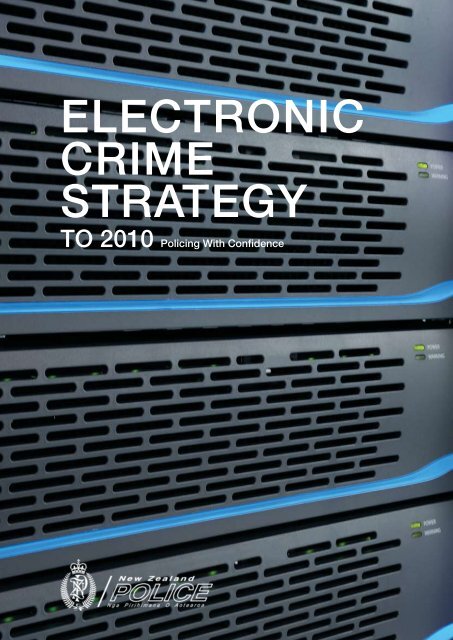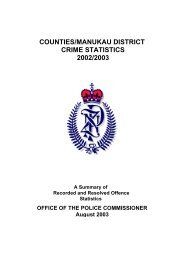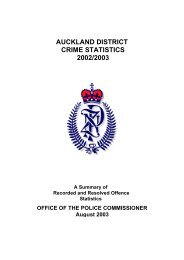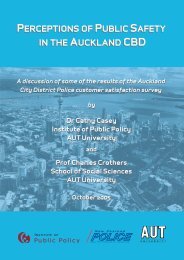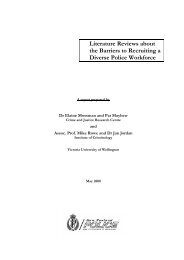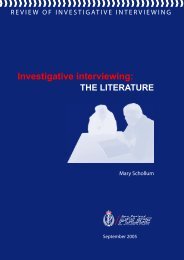Electronic Crime Strategy to 2010 - New Zealand Police
Electronic Crime Strategy to 2010 - New Zealand Police
Electronic Crime Strategy to 2010 - New Zealand Police
Create successful ePaper yourself
Turn your PDF publications into a flip-book with our unique Google optimized e-Paper software.
ELECTRONIC<br />
CRIME<br />
STRATEGY<br />
TO <strong>2010</strong> Policing With Confidence<br />
E-CRIME STRATEGY TO <strong>2010</strong> 1
Commissioner’s<br />
Foreword<br />
<strong>New</strong> communication and computer based technologies offer benefits <strong>to</strong> <strong>New</strong><br />
<strong>Zealand</strong> communities. They also present opportunities for criminals <strong>to</strong> commit<br />
crimes in new ways and provide opportunities <strong>to</strong> inflict harm and cause loss.<br />
The increasing uptake of technology by criminals means some types of crime<br />
can now be committed faster, against more victims, with anonymity and for<br />
greater gain. <strong>Crime</strong>s now occurring in the electronic environment include<br />
traditional offending, such as fraud and paedophilia, and emerging new<br />
crimes such as denial of service attacks and hacking. Of great concern is<br />
organised criminal use of information and communications technology <strong>to</strong><br />
conceal their activities, reach a wide range of victims, and network with<br />
other criminal groups.<br />
Through this strategy, we will ensure that <strong>Police</strong> are positioned <strong>to</strong> address the<br />
use of technology by criminals and can respond <strong>to</strong> new types of electronic<br />
crime (e-crime).<br />
Since 2001, we have been collaborating with Australian Federal and State <strong>Police</strong><br />
in our response <strong>to</strong> e-crime. These arrangements have worked well and we<br />
will continue <strong>to</strong> work closely with the new high-technology crime centre those<br />
agencies have established. However, over the past five years there have also<br />
been developments in <strong>New</strong> <strong>Zealand</strong>, which now make it appropriate for the<br />
<strong>New</strong> <strong>Zealand</strong> <strong>Police</strong> <strong>to</strong> articulate its own strategy.<br />
In recent years we have bolstered the size of our e-crime labora<strong>to</strong>ry, responding<br />
<strong>to</strong> increasing demands for electronic forensic input in<strong>to</strong> criminal investigations,<br />
and we have started <strong>to</strong> train staff about how <strong>to</strong> deal with electronic evidence.<br />
Among our partner agencies, a centre for critical infrastructure protection<br />
(CCIP) has been established <strong>to</strong> address threats <strong>to</strong> critical infrastructure and<br />
Government’s digital strategies have led <strong>to</strong> a variety of other initiatives <strong>to</strong><br />
enhance electronic security and address e-crime.<br />
This strategy places a great deal of focus on a combined agency response<br />
<strong>to</strong> e-crime. <strong>Police</strong> are only one interested party among Government, industry<br />
groups and others playing a role in the security and safety of the electronic<br />
environment. As well as endorsing collaborative approaches, this strategy will<br />
lead <strong>to</strong> further development and maintenance of our own internal capability.<br />
These strategies will ensure that crime reduction capabilities are maintained and<br />
complement the efforts of other organisations involved in keeping <strong>New</strong> <strong>Zealand</strong>’s<br />
electronic systems and their users safe and secure.<br />
Contents<br />
<strong>Electronic</strong> <strong>Crime</strong> 2<br />
Definition 2<br />
Nature of <strong>Electronic</strong> <strong>Crime</strong> Problem 3<br />
Policing Challenges 4<br />
E-<strong>Crime</strong> <strong>Strategy</strong> 5<br />
Strategic Alignment 5<br />
Outcomes 5<br />
Principles 5<br />
Goals and Objectives 6<br />
Organisation 7<br />
Partnerships 9<br />
Capability 11<br />
Integrity 16<br />
<strong>Strategy</strong> Review and Governance 17<br />
Appendix A: National E-<strong>Crime</strong> Structure 18<br />
Appendix B: Summary of Actions 19<br />
Howard Broad<br />
<strong>New</strong> <strong>Zealand</strong> <strong>Police</strong> Commissioner<br />
2 E-CRIME STRATEGY TO <strong>2010</strong> E-CRIME STRATEGY TO <strong>2010</strong> 1
Much e-crime is<br />
unsophisticated. It often involves<br />
activities on the Internet such as<br />
trading s<strong>to</strong>len property through<br />
auction sites, obtaining s<strong>to</strong>len<br />
credit card information from<br />
newsgroups and chat rooms,<br />
distributing pirated intellectual<br />
property, and dealing drugs<br />
through email and websites.<br />
The Internet has provided<br />
considerable opportunity for<br />
many offenders <strong>to</strong> extend<br />
their supply and cus<strong>to</strong>mer<br />
networks and exploit the reach<br />
of the medium – just as it has<br />
provided the same advantages<br />
<strong>to</strong> legitimate users. The use of<br />
technology for these criminal<br />
purposes causes challenges for<br />
<strong>Police</strong> because of sometimes<br />
demanding investigative<br />
requirements and apparent<br />
significant growth in some crime.<br />
<strong>Electronic</strong> <strong>Crime</strong><br />
Definition<br />
<strong>Police</strong> agencies worldwide have struggled <strong>to</strong> define their role in policing e-crime and<br />
<strong>to</strong> understand how <strong>to</strong> be effective in addressing the problem. This is partly because<br />
these types of crimes are extremely diverse. <strong>New</strong> <strong>Zealand</strong> <strong>Police</strong> consider electronic<br />
crime (e-crime) <strong>to</strong> cover:<br />
All offences where information and communications technology is:<br />
1. used as a <strong>to</strong>ol in the commission of an offence<br />
2. the target of an offence<br />
3. a s<strong>to</strong>rage device in the commission of an offence.<br />
E-crime includes traditional offending facilitated by technology such as telephony, the<br />
Internet and encryption. It also involves computer attacks. However, it is important <strong>to</strong><br />
recognise that the bulk of e-crime we currently see is not attributed <strong>to</strong> hackers.<br />
In <strong>New</strong> <strong>Zealand</strong>, e-crime mostly involves traditional offending with components<br />
having electronic means. This includes trading in illegal drugs, fraud, harassment,<br />
and many other types of criminal activity. Information technology has particularly<br />
influenced some traditional offending. Most notably, this includes:<br />
• fraud<br />
• identity theft<br />
• organised crime<br />
• paedophilia<br />
However, e-crime also includes new activity such as attacks on computers and new<br />
opportunities for crime enabled by electronic systems, such as services theft and<br />
software piracy. Worldwide these are significant and new problems.<br />
Nature of <strong>Electronic</strong> <strong>Crime</strong> Problem<br />
Criminals have exploited developments in information and communications<br />
technologies. It has provided them with new <strong>to</strong>ols and facilitated new criminal<br />
activity, which can now target computing infrastructure. Criminals can also exploit<br />
the fact that offending can easily cross jurisdictional boundaries and large distances.<br />
Increasing bandwidth, as well as supporting growth in commerce, is also increasing<br />
opportunities for criminals. Potential victims are becoming increasingly available<br />
as more people use these technologies. Many of these new users represent easy<br />
targets because they lack online security awareness or skills.<br />
Measuring e-crime problems affecting <strong>New</strong> <strong>Zealand</strong> is hampered by a lack of<br />
data for offences involving electronic components. The recent successful transfer<br />
of <strong>Police</strong> operational computer systems <strong>to</strong> NIA (the National Intelligence Application)<br />
and a <strong>Police</strong> <strong>Crime</strong> Statistics <strong>Strategy</strong> provide an opportunity <strong>to</strong> improve<br />
e-crime recording. This should allow for the capture of e-crime connections <strong>to</strong><br />
relevant offences.<br />
Local and Australian victimisation studies have collected some information about<br />
e-crime prevalence, though mainly about computer attacks. Most studies have not<br />
quantified growth in traditional crime facilitated by electronic means. However, <strong>Police</strong><br />
have moni<strong>to</strong>red the demand for forensic analysis of e-crime exhibits by the <strong>Electronic</strong><br />
<strong>Crime</strong> Labora<strong>to</strong>ry (ECL). The number of crimes involving electronic evidence has<br />
increased ten-fold over the past eight years. <strong>Electronic</strong> evidence is increasingly<br />
prominent in some types of offending such as fraud and sexual crime.<br />
Proportion of <strong>Electronic</strong> Exhibits Processed by ECL<br />
Sexual – Indecency 20%<br />
Fraud 18%<br />
Burglary & Theft 13%<br />
Homicide 8%<br />
Threats 4%<br />
Telecommunications Act 4%<br />
Aggravated robbery 3%<br />
Identity crime is one of the<br />
fastest growing types of crime in<br />
the world, and is defined as any<br />
offence involving the misuse of a<br />
personal identity. The majority of<br />
identity crime is committed with<br />
the help of computers.<br />
Identity crime often involves<br />
criminals obtaining information<br />
from everyday transactions like:<br />
• bank and credit card numbers<br />
• names<br />
• addresses<br />
• driver’s license details<br />
• log-on details for other<br />
services<br />
Criminals then use this<br />
information <strong>to</strong> commit fraud<br />
and theft. Opportunities in this<br />
area are increasing with the<br />
development of online auctions,<br />
gaming and other services.<br />
Computer users and businesses<br />
need <strong>to</strong> be vigilant <strong>to</strong> ensure that<br />
personal information is managed<br />
cautiously and with heightened<br />
security. This applies <strong>to</strong> the<br />
security of online transactions,<br />
paper waste containing<br />
sensitive information, personal<br />
details in wallets and purses<br />
and information on portable<br />
computers.<br />
Identity crime is a growing<br />
global problem – it knows<br />
no boundaries; victims and<br />
criminals can be on opposite<br />
sides of the world making it<br />
difficult for local law enforcement<br />
agencies <strong>to</strong> investigate the<br />
crime, catch the perpetra<strong>to</strong>r, or<br />
help the victim.<br />
Drugs 25%<br />
Receiving s<strong>to</strong>len goods 3%<br />
Assault 1%<br />
Kidnapping 1%<br />
Arson 1%<br />
2 E-CRIME STRATEGY TO <strong>2010</strong> E-CRIME STRATEGY TO <strong>2010</strong> 3
The involvement of organised<br />
criminals in e-crime is a concern<br />
<strong>to</strong> <strong>Police</strong>.<br />
Organised criminals exploit<br />
sovereign states that support<br />
illegitimate Internet connections.<br />
These locations offer safe<br />
havens from external authorities<br />
and have limited restrictions<br />
on activities such as trading<br />
pornography, money laundering,<br />
pyramid selling, and other<br />
activities that would be illegal in<br />
many other jurisdictions.<br />
The threat of organised crime<br />
is real. Unfortunately it is very<br />
difficult <strong>to</strong> assess the size and<br />
impact of organised crime<br />
groups. This is because by its<br />
very nature organised criminal<br />
offending is usually hidden.<br />
The increase in organised<br />
criminals’ use of secure<br />
communications technology, the<br />
potential for global reach and the<br />
connection of organised criminal<br />
networks internationally, are<br />
significant concerns <strong>to</strong> <strong>Police</strong>.<br />
Also worrying is the growth<br />
in opportunities for organised<br />
criminal exploitation of electronic<br />
commerce and the new vehicles<br />
that are available for laundering<br />
money and goods that are<br />
facilitated by the Internet.<br />
Other jurisdictions already report<br />
significant organised crime<br />
involvement in the Internet and<br />
the use of other technologies<br />
(such as secure mobile<br />
telephony) by these groups.<br />
Particular evidence exists for<br />
the involvement of organised<br />
crime in credit card fraud, money<br />
laundering and identify theft.<br />
Policing Challenges<br />
The attributes of e-crime pose challenges. These include anonymity, global reach,<br />
the speed by which crime can be committed against multiple victims, the potential<br />
for deliberate exploitation of sovereignty issues, and the volatility of evidence.<br />
These features create obstacles <strong>to</strong> detecting and tracking criminals. Techniques<br />
used by criminals range from false Internet accounts <strong>to</strong> the use of secure Internet<br />
and telephone communications. A particular risk is that the now widespread<br />
availability of encryption enables criminals <strong>to</strong> communicate with each other with<br />
minimal risk of discovery.<br />
Responding <strong>to</strong> these challenges requires expertise and resources beyond the<br />
current capability of mainstream <strong>Police</strong>. Perhaps the biggest problem is the pressure<br />
<strong>to</strong> keep pace with increasing technological sophistication. This includes maintaining<br />
the skills and resources required <strong>to</strong> provide advice on crime prevention, and the<br />
skills required <strong>to</strong> respond, investigate and prosecute offenders. The availability of<br />
these skilled resources within <strong>Police</strong> is limited. Most critically, we face a capability<br />
gap among generalist staff. With many traditional crimes now involving electronic<br />
devices, any lack of knowledge and skills has the potential <strong>to</strong> compromise<br />
investigative outcomes. Importantly though, investigating e-crime still requires many<br />
traditional policing methods that remain a strength of <strong>Police</strong> in <strong>New</strong> <strong>Zealand</strong>.<br />
As a result of the growth in e-crime our specialist forensic capabilities are continually<br />
stretched. There is an ongoing demand <strong>to</strong> grow forensic capabilities <strong>to</strong> keep pace<br />
with the increasing requirements for electronic evidence and <strong>to</strong> provide investiga<strong>to</strong>rs<br />
with assistance required on other technical aspects of e-crime investigations.<br />
In addition <strong>to</strong> limited resources, <strong>Police</strong> face problems with a legislative framework<br />
largely based on physical world constructs. The current regula<strong>to</strong>ry environment<br />
sometimes limits access <strong>to</strong> evidence, because of the dependence of <strong>Police</strong> on<br />
external organisations, such as Internet service providers, <strong>to</strong> enable access <strong>to</strong><br />
information about criminal activity. Criminals also exploit the inter-jurisdictional<br />
difficulties in pursuing investigations.<br />
A public perception that <strong>Police</strong> or other government agencies are not equipped <strong>to</strong><br />
respond <strong>to</strong> e-crime may result in the feeling that there is little benefit in reporting<br />
incidents. In the case of threats <strong>to</strong> electronic commerce or other business activities,<br />
the concerns of business are often continuity and reputation related. Business can<br />
be motivated not <strong>to</strong> report crime because publicity will harm business.<br />
E-<strong>Crime</strong> <strong>Strategy</strong><br />
The e-crime strategy outlines the <strong>Police</strong> approach <strong>to</strong> combat e-crime over the next<br />
five years. The strategy aims <strong>to</strong> better position <strong>Police</strong> <strong>to</strong> deal with e-crime moving<br />
forward – the first steps <strong>to</strong>ward establishing a much larger core of specialist forensic<br />
and investigative expertise.<br />
<strong>New</strong> e-crime prevention and problem-solving approaches are required <strong>to</strong> protect<br />
potential victims and environments. To facilitate these approaches it is necessary<br />
<strong>to</strong> align intelligence systems, <strong>to</strong>ols, investigative requirements and laws <strong>to</strong> address<br />
e-crime issues.<br />
This strategy provides a framework for future planning and will give certainty <strong>to</strong><br />
partner organisations about the directions being followed <strong>to</strong> prevent and respond<br />
<strong>to</strong> e-crime.<br />
Strategic Alignment<br />
The strategy demonstrates commitment <strong>to</strong> <strong>Police</strong>’s high-level outcomes of confident,<br />
safe and secure communities, less actual crime and road trauma, fewer victims, and<br />
a world class <strong>Police</strong> service.<br />
Outcomes<br />
The desired outcomes include:<br />
Principles<br />
• a safe online environment by reducing e-crime offending and minimising<br />
the harm caused <strong>to</strong> people and organisations in <strong>New</strong> <strong>Zealand</strong>, and<br />
• improved e-crime investigative and forensic capability leading <strong>to</strong><br />
increased crime resolution<br />
The following principles guide this e-crime strategy:<br />
• <strong>Police</strong> will adopt a collaborative approach using multi-agency methods<br />
and networks.<br />
• <strong>Police</strong> will not duplicate services or capabilities offered by other<br />
agencies.<br />
• <strong>Police</strong> will adopt knowledge and intelligence-based approaches <strong>to</strong> the<br />
deployment of preventive and detective activities and resources.<br />
• <strong>Police</strong> will engage internationally <strong>to</strong> moni<strong>to</strong>r and respond <strong>to</strong> emerging<br />
risks and opportunities.<br />
The Government is targeting<br />
information and computing<br />
technology growth and<br />
innovation <strong>to</strong> “grow an inclusive,<br />
innovative economy for the<br />
benefit of all”. Achieving this<br />
goal depends on growing <strong>New</strong><br />
<strong>Zealand</strong>ers’ confidence in using<br />
new technologies safely. A safe<br />
and secure digital environment<br />
is essential <strong>to</strong> the success of the<br />
Government’s digital strategies.<br />
One strategy is e-government.<br />
This has been developed<br />
as a vision <strong>to</strong> enable all<br />
<strong>New</strong> <strong>Zealand</strong>ers <strong>to</strong> access<br />
government information and<br />
services using the Internet,<br />
telephones and other<br />
technologies.<br />
The e-government unit is<br />
focused on building electronic<br />
security through initiatives such<br />
as online authentication <strong>to</strong><br />
provide a means for people and<br />
government agencies <strong>to</strong> verify<br />
their authenticity when making<br />
electronic transactions.<br />
4 E-CRIME STRATEGY TO <strong>2010</strong> E-CRIME STRATEGY TO <strong>2010</strong> 5
<strong>Police</strong> Strategic Plan <strong>to</strong> <strong>2010</strong>,<br />
Strategic Goals:<br />
Community Reassurance:<br />
• provide opportunity for<br />
participation<br />
• set local priorities<br />
• work in partnership<br />
• provide protection<br />
Policing with Confidence:<br />
• evidence based proactive<br />
policing<br />
• timely and effective response<br />
<strong>to</strong> calls for service<br />
• thorough investigations<br />
• effective resolutions<br />
Organisational Development:<br />
• leadership and people in<br />
policing<br />
• integrity and accountability<br />
• technology and innovation<br />
Goals and Objectives<br />
<strong>Police</strong> will actively support government goals and initiatives enabling information,<br />
communications, and technology (ICT) in <strong>New</strong> <strong>Zealand</strong> and furthering international<br />
commitments <strong>to</strong> enhance <strong>New</strong> <strong>Zealand</strong>’s cyber security and cyber crime defences.<br />
<strong>Police</strong> will build the capability and credibility <strong>to</strong> effectively investigate and<br />
resolve e-crime.<br />
<strong>Police</strong> will target the following objectives in keeping with overall strategic goals of<br />
community reassurance, policing with confidence, and organisational development.<br />
Key initiatives of Partnerships, Organisation, Capability, and Integrity contribute <strong>to</strong><br />
achieving the objectives.<br />
Community Reassurance<br />
Organisational Development<br />
Policing With Confidence<br />
Partnerships<br />
Responsiveness<br />
Intelligence<br />
Investigations<br />
Forensics<br />
Form significant e-crime prevention and detection<br />
partnerships through collaboration with other<br />
Government, international, and industry groups.<br />
Respond <strong>to</strong> offending by investing in capability<br />
<strong>to</strong> effectively detect and apprehend criminals<br />
where electronic media is used for, or<br />
associated with, the commission of crime.<br />
Adopt an intelligence-based approach <strong>to</strong><br />
analysing e-crime problems, producing quality<br />
information <strong>to</strong> support the deployment of<br />
resources.<br />
Improve front-line investigative capability,<br />
response, and understanding of e-crime<br />
through enhanced skills and <strong>to</strong>ols.<br />
Meet increasing forensic specialist and interjurisdictional<br />
demands, by focussing the ECL<br />
with the capacity, <strong>to</strong>ols and skills <strong>to</strong> meet<br />
international labora<strong>to</strong>ry standards.<br />
Organisation<br />
Integrity<br />
Partnerships<br />
Capability<br />
Organisation<br />
<strong>Police</strong> will demonstrate their commitment and understanding of the significance<br />
and priority surrounding e-crime by establishing the National Cyber <strong>Crime</strong> Centre<br />
(NC3) and aligning the <strong>Electronic</strong> <strong>Crime</strong> Labora<strong>to</strong>ries (ECL) under a single national<br />
structure.<br />
A nationally focussed unit will improve <strong>Police</strong>’s coordination with Government<br />
and key industry groups within <strong>New</strong> <strong>Zealand</strong> and other international groups and<br />
jurisdictions – both at strategic and operational levels.<br />
National Cyber <strong>Crime</strong> Centre (NC3)<br />
The National Cyber <strong>Crime</strong> Centre (NC3) is a specialist e-crime response and<br />
investigation group that will:<br />
• provide a single reporting point for e-crime able <strong>to</strong> be accessed through<br />
traditional telephone reporting channels and through enhanced Internet<br />
contact points, enabling the collection and investigation of complaints<br />
• coordinate <strong>Police</strong>’s response <strong>to</strong> e-crime reported in <strong>New</strong> <strong>Zealand</strong><br />
• coordinate <strong>Police</strong>’s response <strong>to</strong> trans-national e-crime – in which there<br />
can be any combination of <strong>New</strong> <strong>Zealand</strong> or overseas victims, offenders,<br />
and technologies involved in the commission of an offence<br />
• proactively target and electronically patrol places where crime occurs,<br />
focusing on high priority areas such as organised crime, violence, and<br />
online child exploitation<br />
The NC3 will be a national facility with a central base and core team of dedicated<br />
specialists located in Welling<strong>to</strong>n, working closely with the specialist capability already<br />
existing within the ECL. The central Welling<strong>to</strong>n location aligns with key partner<br />
organisational structures and response units eg Centre for Critical Infrastructure<br />
Protection (CCIP), Interpol, Cus<strong>to</strong>ms, and the Department of Internal Affairs (DIA).<br />
The NC3 will complement traditional investigations, assisting initial high-level e-crime<br />
investigations <strong>to</strong> determine criminal activity, and providing specialist assistance<br />
where criminal activities enter the electronic world.<br />
The principles and pro<strong>to</strong>cols surrounding how the NC3 will operate need <strong>to</strong> be<br />
identified and agreed, and this will be cognisant of similar centres established by<br />
other jurisdictions (and their lessons learnt), and any wider sec<strong>to</strong>r initiatives that<br />
might arise <strong>to</strong> establish a <strong>New</strong> <strong>Zealand</strong> based computer emergency response<br />
team (NZCERT).<br />
Appendix A contains a high-level diagram of the e-crime structure.<br />
Australasian <strong>Police</strong> agencies<br />
have established the Australian<br />
High Technology <strong>Crime</strong> Centre<br />
(AHTCC). Its role is <strong>to</strong> provide a<br />
nationally coordinated approach<br />
<strong>to</strong> combating serious, complex<br />
and multi-jurisdictional high<br />
tech crimes (especially those<br />
beyond the capability of single<br />
jurisdictions); <strong>to</strong> assist in<br />
improving the capacity of all<br />
jurisdictions <strong>to</strong> deal with high<br />
tech crime; and <strong>to</strong> support<br />
efforts <strong>to</strong> protect the National<br />
Information Infrastructure.<br />
The United Kingdom set up<br />
a national high-technology<br />
crime unit in the year 2000,<br />
following recommendations of a<br />
computer crime working group<br />
of the Association of <strong>Police</strong><br />
Officers. The unit has since been<br />
transferred in<strong>to</strong> the Serious<br />
Organised <strong>Crime</strong> Agency.<br />
The unit provides e-crime<br />
investigative capability and<br />
maintains a national capability<br />
<strong>to</strong> address e-crime threats. The<br />
unit also supports investigations,<br />
intelligence, technical support,<br />
and forensic retrieval of digital<br />
evidence.<br />
The Royal Canadian Mounted<br />
<strong>Police</strong> have formed a distributed<br />
network of computer crime<br />
response units under the<br />
banner of a Technological <strong>Crime</strong><br />
Program. The group research<br />
and develop computer forensic<br />
<strong>to</strong>ols and provide forensic<br />
assistance <strong>to</strong> domestic and<br />
international accredited agencies<br />
and <strong>Police</strong> services.<br />
6 E-CRIME STRATEGY TO <strong>2010</strong> E-CRIME STRATEGY TO <strong>2010</strong> 7
The ECL evolved in the early <strong>to</strong><br />
mid 1990s, and subsequently<br />
from the necessity for <strong>Police</strong><br />
investiga<strong>to</strong>rs <strong>to</strong> have computer<br />
forensic skills in Districts.<br />
The <strong>Police</strong> Executive approved<br />
the current ECL structure in<br />
Oc<strong>to</strong>ber 2000, and the ECL now<br />
operates with a staff of 18, over<br />
three locations.<br />
Establishment of the ECL<br />
was in line with best practice<br />
models under development by<br />
the Australian Centre for <strong>Police</strong><br />
Research (ACPR). Structured,<br />
high-level coordination at a<br />
national and Australasian level,<br />
and the development of police<br />
capability and capacity were<br />
two of the guiding principles<br />
contained in the <strong>Electronic</strong><br />
<strong>Crime</strong> <strong>Strategy</strong> of the <strong>Police</strong><br />
Commissioners Conference in<br />
March 2001.<br />
The ECL was intended <strong>to</strong><br />
provide the <strong>New</strong> <strong>Zealand</strong> <strong>Police</strong><br />
with a formalised, national<br />
forensic computing capability.<br />
ECL and E-<strong>Crime</strong> Structure<br />
A review of the ECL recommended ways <strong>to</strong> address issues with the ECL staff<br />
turnover rates, training and career structures, and workloads. Several of the<br />
recommendations made have already been implemented. Those remaining include<br />
moving <strong>to</strong> a revised national structure, which is incorporated in<strong>to</strong> a proposed overall<br />
e-crime structure as shown below.<br />
The drivers for restructuring the ECL include:<br />
Admin Officer (1)<br />
Manager R&D (1)<br />
RESEARCH and DEVELOPMENT<br />
POLICY and STRATEGY<br />
– Research & Development<br />
– <strong>Strategy</strong>/new initiatives<br />
– National procurement<br />
– National training<br />
– National standards<br />
• raising the profile of the ECL <strong>to</strong> reflect national rather than District<br />
based response (ECL will continue <strong>to</strong> work with their local Districts for<br />
established local priorities)<br />
• increasing the focus on strategy and development of key partnerships<br />
• maximise the time ECL specialists spend on specialist forensic work,<br />
by providing operational management and administrative support roles<br />
• prepare the ECL for international accreditation (see Integrity section,<br />
page 16) which requires a single ‘authority’ responsible for assigning<br />
responsibilities, accountability, unity of command, and performance<br />
• alignment of the ECL with the proposed NC3<br />
• simplified reporting and line management<br />
• improved consistency of processes across ECL locations<br />
NATIONAL MANAGER: CRIME SERVICES<br />
MANAGER<br />
NATIONAL E-CRIME GROUP<br />
Manager: Operations (1)<br />
NATIONAL ELECTRONIC CRIME LABS<br />
– lab operations (regional and national)<br />
– standards and quality implementation (accreditation)<br />
ECL Positions<br />
E-<strong>Crime</strong> NC3 positions<br />
Det Sen Sgt (1)<br />
NC3<br />
– National Investigations<br />
– Intelligence<br />
– Public response<br />
– NZCERT/CCIP liaison<br />
Partnerships<br />
<strong>Police</strong> cannot effectively address e-crime issues alone. This is because of its size,<br />
complexity, the technical resources required <strong>to</strong> respond, and the limited amount<br />
of reporting <strong>to</strong> <strong>Police</strong> that occurs. These fac<strong>to</strong>rs mean <strong>Police</strong> are dependent on<br />
other organisations. The challenge is <strong>to</strong> enhance cross-agency and public-private<br />
sec<strong>to</strong>r cooperative approaches. This includes combining complementary specialist<br />
expertise, intelligence and other resources.<br />
<strong>Police</strong> continue <strong>to</strong> encourage organisations that enhance security of the electronic<br />
environment. The wider government sec<strong>to</strong>r is already showing leadership on these<br />
issues through its digital strategy and e-Government initiatives. <strong>Police</strong> will continue <strong>to</strong><br />
contribute enforcement perspectives <strong>to</strong> these initiatives.<br />
From <strong>Police</strong>’s perspective, the objectives of these partnerships is <strong>to</strong> promote<br />
security policies, private sec<strong>to</strong>r leadership (including self-regulation), and government<br />
regulation where required. <strong>Police</strong> wish <strong>to</strong> ensure that significant crimes are prevented<br />
and that the electronic environment retains the community’s trust and confidence.<br />
Government<br />
The Centre for Critical Infrastructure Protection (CCIP) is the main government<br />
agency focused on protecting public and private organisations that supply services<br />
such as power, telecommunications and health care from computer misuse and<br />
hacking. <strong>Police</strong> will coordinate with the CCIP in responding <strong>to</strong> e-crime incidents<br />
affecting critical services, formalising requirements <strong>to</strong> collect evidence and meet<br />
other criminal investigative obligations.<br />
The other operational agencies involved with <strong>Police</strong> in responding <strong>to</strong> reports<br />
of e-crime are the Cus<strong>to</strong>ms Service, Security and Defence agencies, and the<br />
Department of Internal Affairs. <strong>Police</strong> will continue relationships with these agencies,<br />
building pro<strong>to</strong>cols for effective coordination through mechanisms such as Combined<br />
Law Agency Groups, the Departmental Committee on Computer Security (which<br />
sets and reviews national computer security policies) and the Officials’ Committee for<br />
Domestic and External Security.<br />
The Information Technology and Telecommunications Policy Group in the Ministry<br />
of Economic Development, the ICT branch in the State Services Commission,<br />
and CCIP all initiate activities that require <strong>Police</strong> support. <strong>Police</strong> will support and<br />
contribute law enforcement perspectives <strong>to</strong> these initiatives.<br />
In the case of business or<br />
government infrastructure, it<br />
is important that any systems<br />
compromised in a computer<br />
attack are res<strong>to</strong>red as quickly<br />
as possible.<br />
Owners of <strong>New</strong> <strong>Zealand</strong>’s critical<br />
infrastructure are provided with<br />
government support <strong>to</strong> protect<br />
and res<strong>to</strong>re critical services.<br />
The Centre for Critical<br />
Infrastructure Protection (CCIP)<br />
provides this support.<br />
<strong>New</strong> <strong>Zealand</strong> <strong>Police</strong> work<br />
closely with the CCIP <strong>to</strong><br />
ensure that alongside any<br />
need <strong>to</strong> re-establish critical<br />
services, requirements for<br />
evidence are fulfilled in the<br />
event that this may be required<br />
in a criminal investigation.<br />
The CCIP is a unit of the<br />
Government Communications<br />
Security Bureau. It has a web<br />
site at www.ccip.govt.nz<br />
The ICT group of the State<br />
Services Commission (SSC)<br />
has proposed a Computer<br />
Emergency Response Team<br />
(CERT) in response <strong>to</strong> various<br />
international commitments under<br />
OECD, APEC and the ASEAN<br />
Regional Forum, aimed at<br />
promoting trust and confidence<br />
in information technologies in<br />
<strong>New</strong> <strong>Zealand</strong>. A CERT closely<br />
aligns with the CCIP functions,<br />
but provides cover beyond<br />
critical infrastructure, for key<br />
societal and commercial sec<strong>to</strong>rs<br />
as well as the public.<br />
Forensic<br />
Architects (4)<br />
ECL South<br />
Supv Analyst (1)<br />
ECL Central<br />
Supv Analyst (1)<br />
ECL North<br />
Supv Analyst (1)<br />
Det Sgt (1)<br />
Sys Admin (1)<br />
Signal Proc (2)<br />
Analysts (3)<br />
Analysts (3)<br />
Analysts (5) Detectives (2)<br />
Admin Asst (1)<br />
Admin Asst (1)<br />
Admin Asst (1)<br />
8 E-CRIME STRATEGY TO <strong>2010</strong> E-CRIME STRATEGY TO <strong>2010</strong> 9
The <strong>Crime</strong>s Amendment Act<br />
2003 came in<strong>to</strong> effect on<br />
1 Oc<strong>to</strong>ber 2003 and created<br />
four distinct new computer<br />
crimes.<br />
1. Accessing a computer<br />
system for a dishonest<br />
purpose.<br />
2. Damaging or interfering with a<br />
computer system.<br />
3. Making, selling, distributing<br />
or possessing software for<br />
committing crimes.<br />
4. Accessing a computer<br />
system without authorisation.<br />
This legislation now gives strong<br />
new protection against hackers.<br />
The Telecommunications<br />
(Interception Capability) Act<br />
2004 came in<strong>to</strong> force on<br />
5 April 2004. That Act allows<br />
<strong>Police</strong> <strong>to</strong> effectively carry<br />
out the lawful interception of<br />
telecommunications under an<br />
interception warrant obtained in<br />
circumstances such as where<br />
there are grounds for believing<br />
there is an organised criminal<br />
enterprise, serious violent<br />
offence, or drug dealing offence.<br />
A network opera<strong>to</strong>r must ensure<br />
that they provide an interception<br />
capability (although there is<br />
up <strong>to</strong> a five-year lead-in time<br />
for existing network opera<strong>to</strong>rs<br />
<strong>to</strong> provide the necessary<br />
interception capability). This law<br />
brings <strong>New</strong> <strong>Zealand</strong> in<strong>to</strong> line<br />
with other countries that allow<br />
their law enforcement agencies<br />
similar access.<br />
Industry<br />
The Security Research Group (SRG) of the University of Otago in partnership with<br />
the Computer Security Institute (CSI), the CCIP and <strong>Police</strong>, produced the 2005 <strong>New</strong><br />
<strong>Zealand</strong> Computer <strong>Crime</strong> and Security Survey of <strong>New</strong> <strong>Zealand</strong> businesses. The<br />
2005 survey found 60% of respondent organisations had experienced electronic<br />
attacks originating outside the organisation, showing a steady growth over the past<br />
five years. Average annual losses were estimated at $43,000 per organisation.<br />
Prevention of e-crime relies on industry organisations and public awareness. Having<br />
an effective regula<strong>to</strong>ry environment helps <strong>to</strong> ensure that organisations take measures<br />
<strong>to</strong> protect consumers. <strong>Police</strong> will support groups such as the Internet Safety Group,<br />
who assist in heightening community awareness and provide policy responses <strong>to</strong><br />
e-crime issues.<br />
Specialist ICT sec<strong>to</strong>r input is required for an effective response <strong>to</strong> many types of<br />
e-crime. <strong>Police</strong> will work with Internet service and telecommunication providers <strong>to</strong><br />
enable access <strong>to</strong> records of traffic information <strong>to</strong> assist the investigation of crime<br />
(pursuant <strong>to</strong> search warrants).<br />
It is essential <strong>to</strong> keep abreast of technology trends and changes in commonly used<br />
technology. <strong>Police</strong> will continue <strong>to</strong> establish and maintain relationships with major<br />
technology stakeholders, eg Microsoft and Cisco.<br />
International<br />
International partners include the G8 sub-group on High Tech <strong>Crime</strong>, Interpol, and<br />
the US Federal Bureau of Investigation. The South Pacific Chiefs of <strong>Police</strong> forum and<br />
the Australasian <strong>Police</strong> Ministers Council (APMC) are forums <strong>to</strong> coordinate regional<br />
response capability. <strong>Police</strong> will work with the APMC <strong>to</strong> improve the regular sharing of<br />
information, skills and response capability among e-crime managers.<br />
Inter-jurisdictional responses <strong>to</strong> e-crime are reliant on solid relationships and<br />
cooperation with international law enforcement organisations. <strong>Police</strong> will work with<br />
the United Nations Convention against Trans-National Organised <strong>Crime</strong> <strong>to</strong> address<br />
issues hindering <strong>Police</strong> ability <strong>to</strong> deal with international jurisdictions, including<br />
provision of mutual legal assistance, extradition, law-enforcement cooperation and<br />
technical assistance.<br />
Exhibits<br />
Capability<br />
Enhancing the skills <strong>to</strong> gather and assess electronic evidence is required <strong>to</strong> deal<br />
with information and communication technology issues that now confront many<br />
investigations. Equipping detectives and other staff with the skills <strong>to</strong> recognise and<br />
deal with electronic evidence will ensure that skills are available <strong>to</strong> conduct most<br />
<strong>Police</strong> investigations.<br />
<strong>Police</strong> maintain the ECL <strong>to</strong> provide forensic support <strong>to</strong> investigations and<br />
prosecutions. These serve <strong>Police</strong> and other law enforcement agencies. The ECL<br />
currently comprises 18 staff located in Auckland, Welling<strong>to</strong>n and Dunedin. Their<br />
capabilities include signal processing, computer examination, forensic software<br />
development, and the search and seizure of electronic evidence. The group also<br />
maintains partnerships with computer crime agencies and links <strong>to</strong> Internet and<br />
telecommunications providers.<br />
For the past five years, the ECL has experienced significant growth in demand.<br />
During 2003, requests were received for the analysis of 16,300 items of forensic<br />
evidence. 1 This demand outstrips the ability of the labora<strong>to</strong>ry <strong>to</strong> service the majority<br />
of investigations involving electronic evidence.<br />
Number of Exhibits Presented <strong>to</strong> ECL<br />
18000<br />
16000<br />
14000<br />
12000<br />
10000<br />
8000<br />
6000<br />
4000<br />
2000<br />
0<br />
1990 1991 1992 1993 1994 1995 1996 1997 1998 1999 2000 2001 2002 2003<br />
Essentially, the identification and recovery of electronic evidence can be grouped in<strong>to</strong><br />
three levels of complexity:<br />
Level 1: Identification of directly visible evidence<br />
Level 2: More intensive searching of contents and recovery of data (eg deleted<br />
files) <strong>to</strong> identify less obvious or latent evidence using specialist equipment<br />
and <strong>to</strong>ols<br />
Year<br />
The availability of computer<br />
evidence is increasingly<br />
providing <strong>Police</strong> investigations<br />
with powerful evidence.<br />
Criminals use computer<br />
devices for record keeping, as<br />
communication <strong>to</strong>ols <strong>to</strong> plan<br />
crimes, as devices <strong>to</strong> execute<br />
fraud, <strong>to</strong> transmit pirated<br />
software, and a host of other<br />
illegal activities. In some cases,<br />
computers may simply serve as<br />
a silent “witness” <strong>to</strong> a crime by<br />
s<strong>to</strong>ring information relating <strong>to</strong><br />
the offending.<br />
A criminal’s computer often<br />
contains incriminating evidence<br />
that might never have been<br />
accessible 20 years ago.<br />
For example, criminals using<br />
the Internet leave behind a trail<br />
of evidence that <strong>Police</strong> and<br />
other law enforcement agencies<br />
can use <strong>to</strong> identify them and<br />
their offending.<br />
Level 3:<br />
External specialist expertise required, eg from hardware vendors.<br />
1 Comparable statistics indicating the investigative demand for recovering e-crime exhibits are not<br />
available from 2004 onwards. This is because submission processes were changed during 2004<br />
<strong>to</strong> relieve pressure on the ECL by restricting submissions <strong>to</strong> high priority exhibits, as determined<br />
by District <strong>Crime</strong> Managers.<br />
10 E-CRIME STRATEGY TO <strong>2010</strong> E-CRIME STRATEGY TO <strong>2010</strong> 11
Dunedin-based ECL staff have<br />
been operating preview clinics<br />
for one week of each month, in<br />
Christchurch.<br />
The clinic provides an<br />
opportunity <strong>to</strong> preview seized<br />
electronic equipment and identify<br />
any obvious evidence.<br />
Many of the cases previewed<br />
at the clinic might otherwise not<br />
have been submitted <strong>to</strong> the ECL.<br />
In one clinic alone, of the<br />
36 items previewed:<br />
• 5 contained evidence of<br />
child abuse or objectionable<br />
material<br />
• 10 provided leads <strong>to</strong> aid in<br />
associated investigations<br />
• 3 contained evidence of<br />
money laundering or fraud<br />
• 8 items identified suspects in<br />
receiving or burglary cases<br />
• 1 contained evidence relating<br />
<strong>to</strong> a drugs investigation<br />
• 1 was submitted for further<br />
specialist analysis and<br />
recovery at the ECL<br />
When the ECL was first established, specialist skills and equipment were needed<br />
<strong>to</strong> perform Level 1 analysis, requiring that all jobs relating <strong>to</strong> electronic evidence be<br />
submitted <strong>to</strong> the ECL for full analysis and evidence recovery.<br />
Technology has since moved on, and more <strong>to</strong>ols are now available, making it easier<br />
for non-specialist staff <strong>to</strong> perform Level 1 analysis (with assistance from the ECL).<br />
This development has yet <strong>to</strong> be reflected in the workload of the ECLs with most jobs<br />
still submitted for full analysis.<br />
The proposed development of additional <strong>to</strong>ols will simplify some Level 2 analysis<br />
enabling more identification of evidence by staff outside the ECL, and reduction in<br />
the overall ECL workload.<br />
Improving Frontline Capability<br />
The high ECL workload is resulting in delays in processing electronic items, which<br />
can compromise investigative outcomes. Moving Level 1 activities from the specialist<br />
ECL <strong>to</strong> frontline staff (supported by the ECL) will enable a faster turnaround time and<br />
reduce the ECL workload.<br />
Preview clinics take the ECL specialist capability out <strong>to</strong> each District on a<br />
regular basis, with ECL staff working alongside investiga<strong>to</strong>rs <strong>to</strong> securely (without<br />
endangering the exhibit or potential evidence) view the contents of seized computers<br />
or disks and identify items of interest. Such Level 1 type analysis will often identify<br />
all that is needed for the investigation, although subsequent Level 2 type analysis<br />
can be initiated if required. This approach enables a focussed investigation of<br />
disk contents, and avoids specialist effort on misdirected analysis and<br />
unneccessary reporting.<br />
Preview clinics are already held each month in Christchurch, and although the<br />
number of items previewed each month may vary, there is a consistently high<br />
success rate (refer sidebar).<br />
<strong>Police</strong> will extend the use of preview clinics <strong>to</strong> each District.<br />
Recovery of evidence from mobile phones is another growth area for the ECL.<br />
The extraction of pho<strong>to</strong>s or other information contained on a mobile phone in an<br />
evidentially safe manner requires some specialist <strong>to</strong>ols that can be made available <strong>to</strong><br />
frontline staff.<br />
Mobile phone booths have already been established in some Districts enabling local<br />
staff <strong>to</strong> obtain information (eg, pho<strong>to</strong>s, messages, contacts, or complete SIM dump)<br />
directly from seized mobile phones, without intervention from ECL staff.<br />
<strong>Police</strong> will implement mobile phone booths in each District with appropriate support<br />
and guidance for District staff.<br />
District Liaison<br />
Improved communications <strong>to</strong> frontline staff will aid their understanding of e-crime,<br />
electronic evidence, and the services available through the ECL. Introduction of the<br />
above initiatives will also require assistance from Districts <strong>to</strong> provide local liaison<br />
points, contacts for scheduling preview sessions, and <strong>to</strong> generally act as a local<br />
champion for the ECL.<br />
E-<strong>Crime</strong> Liaison Officers are proposed for each District – either as a dedicated staff<br />
member or in conjunction with other duties (depending on each District’s size and<br />
requirements).<br />
<strong>Police</strong> will appoint E-<strong>Crime</strong> Liaison Officers for each District <strong>to</strong> facilitate local ECL<br />
activities and communications.<br />
Research<br />
<strong>Police</strong> wish <strong>to</strong> build an accurate picture of e-crime offending and continue <strong>to</strong><br />
encourage all victims <strong>to</strong> report offences. We need this picture because crime<br />
reduction relies on understanding the criminal environment as a critical first step in<br />
effective problem solving. The intelligence picture will be used <strong>to</strong> influence public and<br />
private sec<strong>to</strong>r organisations and individuals who can impact on electronic security.<br />
<strong>Police</strong> will encourage the sponsorship of research <strong>to</strong> clarify the extent, scope, and<br />
impact of e-crime in the <strong>New</strong> <strong>Zealand</strong> setting.<br />
<strong>Police</strong> will collect and analyse e-crime data, providing intelligence and direction <strong>to</strong><br />
investigations, and strategies <strong>to</strong> address e-crime.<br />
An E-<strong>Crime</strong> Liaison Officer in<br />
each District can:<br />
• liaise with the ECL over case<br />
submissions and priorities<br />
• assist investiga<strong>to</strong>rs in using<br />
provided <strong>to</strong>ols <strong>to</strong> identify<br />
evidence<br />
• assist ECL staff in scheduling<br />
preview clinics and sessions<br />
• prepare exhibits for preview<br />
sessions<br />
• provide guidance for District<br />
staff in seizing electronic<br />
exhibits<br />
• provide onsite support<br />
for mobile phone booths,<br />
assisting staff and maintaining<br />
equipment<br />
• coordinate the<br />
introduction of ECL initiatives<br />
(eg Project EVE)<br />
12 E-CRIME STRATEGY TO <strong>2010</strong> E-CRIME STRATEGY TO <strong>2010</strong> 13
Environment for Virtualised Evidence (EVE)<br />
Current inability <strong>to</strong> process the high volume of electronic exhibits seized during police<br />
investigations has prompted the need <strong>to</strong> develop a more effective system <strong>to</strong> conduct<br />
these types of specialist investigations.<br />
Project EVE involves the development of a virtual forensic evidence recovery<br />
environment that will move the ability for general investigative interrogation <strong>to</strong> front<br />
line investiga<strong>to</strong>rs via specifically targeted search <strong>to</strong>ols. This approach will save<br />
resources within the specialist ECL being used <strong>to</strong> conduct a host of more mundane<br />
queries and move this functionality directly <strong>to</strong> the investiga<strong>to</strong>r and/or Scene of <strong>Crime</strong><br />
Officers (SOCOs).<br />
EVE will improve investigative capability, better positioning <strong>Police</strong> <strong>to</strong> manage both<br />
current demand and the expected increase in electronic-related crime.<br />
<strong>Police</strong> will implement EVE nationwide, including:<br />
• a targeted training programme for ECL staff and frontline investiga<strong>to</strong>rs<br />
• a mobile EVE for use in court or for investigation at crime scenes or<br />
remote areas<br />
Once proven, there is potential <strong>to</strong> make EVE available <strong>to</strong> other enforcement groups<br />
and jurisdictions, providing benefits beyond <strong>Police</strong>.<br />
E-SOCO<br />
Ensuring appropriate seizure and preservation of computer items for forensic<br />
examination is essential <strong>to</strong> obtaining electronic evidence. EVE simplifies some of<br />
these tasks, reducing the reliance on ECL specialists.<br />
Providing trained e-SOCOs <strong>to</strong> carry out this work will ensure integrity of evidence<br />
is maintained, while reducing the lead time in making such evidence available <strong>to</strong><br />
frontline investiga<strong>to</strong>rs. This will also further reduce the ECL workload, enabling more<br />
focus on specialist evidence recovery.<br />
<strong>Police</strong> will establish the role of e-SOCO, with appropriate training and procedures,<br />
enabling the seizure and transformation of electronic evidence in<strong>to</strong> EVE, without<br />
involvement being required from the ECL.<br />
European Convention on Cyber <strong>Crime</strong><br />
The European Convention on Cyber <strong>Crime</strong> came in<strong>to</strong> force in November 2001,<br />
recognising the urgent need <strong>to</strong> pursue a common criminal policy aimed at the<br />
protection of society against cyber-crime especially, by adopting appropriate<br />
legislation and fostering cooperation between countries and private industry in<br />
combating cyber crime.<br />
Countries signing up <strong>to</strong> the convention are required <strong>to</strong> meet legislative standards<br />
guiding the definition and response <strong>to</strong> cyber crime. <strong>New</strong> <strong>Zealand</strong> legislation<br />
appears <strong>to</strong> align with the convention’s requirements; however these need <strong>to</strong> be<br />
reviewed in detail.<br />
As well as aligning legislation with e-crime internationally, the core benefit for <strong>Police</strong><br />
is the ability <strong>to</strong> progress cyber-based investigations across borders with other<br />
participating countries, extending the reach and speed of investigations.<br />
Currently any evidence obtained<br />
from the examination of<br />
electronic equipment by ECL<br />
staff is s<strong>to</strong>red on individual<br />
hard drives that are held within<br />
caddies and need <strong>to</strong> be loaded<br />
manually for each case <strong>to</strong> be<br />
examined.<br />
With EVE, when a computer<br />
is seized and provided <strong>to</strong> the<br />
ECL, staff will create a virtual<br />
‘image’ from the physical<br />
computer then run specialist<br />
analysis and indexing <strong>to</strong>ols <strong>to</strong><br />
enable the search capability. The<br />
virtual copy is then placed on a<br />
S<strong>to</strong>rage Area Network (SAN) and<br />
made available <strong>to</strong> the frontline<br />
investiga<strong>to</strong>r via the <strong>Police</strong><br />
enterprise network.<br />
When an investiga<strong>to</strong>r accesses<br />
the virtual copy it is loaded as<br />
a virtual machine and they can<br />
then see the computer in the<br />
same way the suspect sees<br />
it. Using simple search <strong>to</strong>ols<br />
the investiga<strong>to</strong>r can quickly<br />
search through the data on the<br />
computer <strong>to</strong> identify anything<br />
relevant <strong>to</strong> the investigation.<br />
The introduction of EVE is<br />
expected <strong>to</strong> reduce lead times<br />
in obtaining electronic evidence<br />
from months down <strong>to</strong> days,<br />
significantly increasing the<br />
throughput of the ECL and the<br />
investigative capability of the<br />
investiga<strong>to</strong>rs.<br />
<strong>Police</strong> will drive any legislative changes required and progress <strong>New</strong> <strong>Zealand</strong>’s<br />
adoption of the European Convention on Cyber <strong>Crime</strong>.<br />
The Council of Europe is made<br />
up of 46 member states.<br />
The European Convention<br />
on Cyber <strong>Crime</strong> is the first<br />
international treaty on crimes<br />
committed via the Internet<br />
and other computer networks,<br />
dealing particularly with<br />
infringements of copyright,<br />
computer-related fraud, child<br />
pornography and violations<br />
of network security. It also<br />
contains a series of powers and<br />
procedures such as the search<br />
of computer networks and<br />
interception.<br />
The Convention is the product<br />
of four years of work by Council<br />
of Europe experts, but also by<br />
the United States, Canada,<br />
Japan and other countries<br />
which are not members of the<br />
organisation.<br />
An additional pro<strong>to</strong>col<br />
supplementing the Convention<br />
makes any publication of racist<br />
and xenophobic propaganda via<br />
computer networks a criminal<br />
offence.<br />
Non-European states who have<br />
signed up <strong>to</strong> the Convention<br />
include:<br />
• United States<br />
• Canada<br />
• Japan<br />
• South Africa<br />
14 E-CRIME STRATEGY TO <strong>2010</strong> E-CRIME STRATEGY TO <strong>2010</strong> 15
The <strong>Crime</strong> Labora<strong>to</strong>ry<br />
Accreditation Program of the<br />
American Society of <strong>Crime</strong><br />
Labora<strong>to</strong>ry Direc<strong>to</strong>rs/Labora<strong>to</strong>ry<br />
Accreditation Board (ASCLD/<br />
LAB) is a voluntary program in<br />
which any crime labora<strong>to</strong>ry may<br />
participate <strong>to</strong> demonstrate that<br />
its management, operations,<br />
personnel, procedures,<br />
equipment, physical plant,<br />
security, and health and safety<br />
procedures meet established<br />
standards.<br />
Accreditation is granted for a<br />
period of five years provided that<br />
a labora<strong>to</strong>ry continues <strong>to</strong> meet<br />
ASCLD/LAB standards.<br />
Labora<strong>to</strong>ries in <strong>New</strong> <strong>Zealand</strong><br />
with current ASCLD/LAB<br />
accreditation are:<br />
• ESR<br />
• <strong>Police</strong> Document Examination<br />
Service<br />
Integrity<br />
The growth in e-crime places increased reliance on electronic (or digital) evidence.<br />
The integrity of digital evidence and the process by which it is obtained is essential in<br />
successfully prosecuting e-crime.<br />
Labora<strong>to</strong>ry accreditation provides <strong>Police</strong>, Courts, <strong>New</strong> <strong>Zealand</strong> enforcement<br />
agencies and their international counterparts with assurance as <strong>to</strong> the standard of<br />
forensics examination. This is particularly important in international investigations<br />
where evidence recovered by the ECL is presented in courts overseas.<br />
ECL Accreditation<br />
Accreditation shows that the ECL meets international standards for forensic<br />
examination of digital evidence. Accreditation forms part of a labora<strong>to</strong>ry’s quality<br />
assurance programme, which also includes proficiency-testing, continuing<br />
education, and other programmes <strong>to</strong> help the labora<strong>to</strong>ry give better overall service <strong>to</strong><br />
the criminal justice system.<br />
The American Society of <strong>Crime</strong> Labora<strong>to</strong>ry Direc<strong>to</strong>rs/Labora<strong>to</strong>ry Accreditation Board<br />
(ASCLD/LAB) is an internationally recognised accreditation programme, based on<br />
the ISO 17025 standard.<br />
Preparation for accreditation can be a lengthy process, ensuring that identified<br />
standards and processes are in use for:<br />
• administration and resourcing (including budget, management<br />
information systems, job descriptions, performance reviews)<br />
• organisational structure and delegation of authority (see also ECL and<br />
E-<strong>Crime</strong> Structure, page 8)<br />
• evidence control and quality management<br />
• personnel qualifications and proficiency testing<br />
<strong>Strategy</strong> Review<br />
and Governance<br />
The governance of this e-crime strategy and the measures arising from it reach<br />
across many areas of policing. These include operational responses <strong>to</strong> e-crime<br />
prevention and investigation and the development of <strong>Police</strong> capabilities through<br />
training, research and resource development.<br />
E-crime also reaches across traditional crime areas and criminal groups as well<br />
as some having new features that have emerged with the growth of the electronic<br />
environment.<br />
The strategies in this document also affect a wide variety of <strong>Police</strong> staff and<br />
domestic and international partner agencies.<br />
Because of the diversity of measures required <strong>to</strong> address e-crime, it is appropriate<br />
that the Commissioners govern this strategy. Key roles include:<br />
• Executive Sponsor: Deputy Commissioner, Operations<br />
• Business Owner: National Manager, <strong>Crime</strong> Services<br />
• Performance Management and Review: Assistant Commissioner,<br />
<strong>Strategy</strong>, Policy, and Performance<br />
The key elements of governance include:<br />
• an annual progress report <strong>to</strong> the <strong>Police</strong> Executive of the strategy and its<br />
impact<br />
• incorporation of actions in<strong>to</strong> the performance management framework<br />
Implementation of the E-<strong>Crime</strong><br />
<strong>Strategy</strong> <strong>to</strong> <strong>2010</strong> involves several<br />
key initiatives.<br />
Additional capability will need<br />
<strong>to</strong> be acquired or reallocated by<br />
<strong>Police</strong>, <strong>to</strong> fund the key initiatives<br />
and the ongoing development<br />
and participation in key<br />
partnerships and forums.<br />
The next steps in progressing<br />
the E-<strong>Crime</strong> <strong>Strategy</strong> include:<br />
• prioritise initiatives and assign<br />
ownership<br />
• agree a programme of work<br />
and associated resourcing<br />
requirements<br />
• incorporate initiatives in<strong>to</strong><br />
annual business plans /<br />
prepare business cases as<br />
required<br />
• physical layout and lab conditions (including security, design, health<br />
and safety)<br />
<strong>Police</strong> will implement formalised standard operating procedures, high-quality exhibit<br />
management, appropriate lab conditions, and other national practices required <strong>to</strong><br />
achieve ASCLD/LAB international accreditation.<br />
• a review of the strategy <strong>to</strong> be completed by 30 September 2009<br />
Risks and issues associated with this strategy will be identified as part of the<br />
business unit planning process and in consultation with the Risk Advisor and the<br />
Organisational Performance Group. The planning will cover strategic and operational<br />
risks in relation <strong>to</strong> services, capability, and change.<br />
16 E-CRIME STRATEGY TO <strong>2010</strong> E-CRIME STRATEGY TO <strong>2010</strong> 17
Appendix A:<br />
National E-<strong>Crime</strong> Structure<br />
Appendix B:<br />
Summary of Actions<br />
Government<br />
Industry<br />
Netsafe, etc<br />
<strong>Police</strong> Executive<br />
<strong>Strategy</strong>/Governance<br />
Relationships<br />
Management<br />
International<br />
Agencies, Groups,<br />
and Forums<br />
E-<strong>Crime</strong><br />
Initiative<br />
Actions<br />
Organisation 1. Develop, agree, and implement the<br />
national e-crime structure for the<br />
<strong>Electronic</strong> <strong>Crime</strong> Labora<strong>to</strong>ry (ECL).<br />
Timing<br />
Owner<br />
2007 <strong>Electronic</strong> <strong>Crime</strong><br />
Labora<strong>to</strong>ry<br />
Success Indica<strong>to</strong>rs<br />
• national service provision with<br />
single line reporting<br />
• the ECL is responsive <strong>to</strong> District<br />
workload pressures<br />
• there is consistency of operation<br />
across all ECL facilities<br />
Investigative/Intelligence<br />
National Operations<br />
Forensics/R&D<br />
2. Develop, agree, and implement the<br />
national e-crime structure for the National<br />
Cyber <strong>Crime</strong> Centre (NC3).<br />
2008 <strong>Crime</strong> Service<br />
Centre<br />
• <strong>Police</strong> are responsive <strong>to</strong><br />
requests for assistance in<br />
investigating cyber crime<br />
Interpol<br />
Public<br />
Centre for Critical Infrastructure<br />
Protection (CCIP)<br />
Computer Emergency Response<br />
Team (CERT)<br />
Industry (Telecom, Internet Service Providers)<br />
National<br />
Cyber<br />
<strong>Crime</strong><br />
Centre<br />
(Welling<strong>to</strong>n)<br />
<strong>Electronic</strong><br />
<strong>Crime</strong><br />
Labora<strong>to</strong>ry<br />
Courts<br />
(NZ and International)<br />
Capability 3. <strong>Police</strong> will extend the use of preview<br />
clinics <strong>to</strong> each District.<br />
4. <strong>Police</strong> will implement mobile phone<br />
booths in each District with appropriate<br />
support and guidance for District staff.<br />
5. <strong>Police</strong> will appoint E-<strong>Crime</strong> Liaison<br />
Officers for each District <strong>to</strong> facilitate local<br />
ECL activities and communications.<br />
6. Develop and implement the Environment<br />
for Virtualised Evidence (EVE), including:<br />
– a targeted training programme for ECL<br />
staff and frontline investiga<strong>to</strong>rs<br />
2007 <strong>Electronic</strong> <strong>Crime</strong><br />
Labora<strong>to</strong>ry<br />
2007 <strong>Electronic</strong> <strong>Crime</strong><br />
Labora<strong>to</strong>ry<br />
2007 Districts<br />
2008 <strong>Electronic</strong> <strong>Crime</strong><br />
Labora<strong>to</strong>ry<br />
• preview clinics and mobile<br />
phone booths provide<br />
investiga<strong>to</strong>rs with results in a<br />
short timeframe<br />
• ECL staff are focussed on<br />
specialist analysis and evidence<br />
recovery, with reduced delays<br />
for investigations<br />
• Investiga<strong>to</strong>rs are using EVE with<br />
success in resolving crimes<br />
• improved understanding of<br />
e-crime and electronic evidence<br />
throughout <strong>Police</strong><br />
– a mobile EVE<br />
Investigations<br />
(NZ and International)<br />
E-SOCO<br />
(Districts)<br />
7. Establish the role of e-SOCO, appoint<br />
and train e-SOCOs in the identification<br />
and preservation of electronic evidence,<br />
including transformation of evidence in<strong>to</strong><br />
EVE.<br />
2009 <strong>Electronic</strong> <strong>Crime</strong><br />
Labora<strong>to</strong>ry<br />
• improved identification and<br />
seizure of electronic items for<br />
evidence recovery<br />
• short lead times for Investiga<strong>to</strong>rs<br />
<strong>to</strong> access electronic evidence<br />
8. Review legislation alignment with<br />
European Convention on Cyber <strong>Crime</strong>,<br />
driving any changes required and<br />
progressing <strong>New</strong> <strong>Zealand</strong>’s adoption of<br />
the convention.<br />
2009 <strong>Electronic</strong> <strong>Crime</strong><br />
Labora<strong>to</strong>ry<br />
• progress in ratifying the<br />
convention<br />
9. Encourage the sponsorship of research<br />
<strong>to</strong> clarify the extent, scope, and impact of<br />
e-crime in the <strong>New</strong> <strong>Zealand</strong> setting.<br />
ongoing<br />
<strong>Electronic</strong> <strong>Crime</strong><br />
Labora<strong>to</strong>ry<br />
• <strong>Police</strong> have a clear<br />
understanding of the extent,<br />
scope, and impact of cyber<br />
crime in <strong>New</strong> <strong>Zealand</strong><br />
10. <strong>Police</strong> will collect and analyse e-crime<br />
data, providing intelligence and direction<br />
<strong>to</strong> investigations, and strategies <strong>to</strong><br />
address e-crime.<br />
2009 <strong>Electronic</strong> <strong>Crime</strong><br />
Labora<strong>to</strong>ry<br />
18 E-CRIME STRATEGY TO <strong>2010</strong> E-CRIME STRATEGY TO <strong>2010</strong> 19
E-<strong>Crime</strong><br />
Initiative<br />
Actions<br />
Timing<br />
Owner<br />
Success Indica<strong>to</strong>rs<br />
Integrity<br />
11. Obtain international accreditation of<br />
the ECL, based on the ASCLD/LAB<br />
International accreditation programme for<br />
Digital Evidence.<br />
2009 <strong>Electronic</strong> <strong>Crime</strong><br />
Labora<strong>to</strong>ry<br />
• the ECL is a world class and<br />
internationally accredited<br />
forensic labora<strong>to</strong>ry<br />
• consistency of practices and<br />
standards across all ECL<br />
facilities<br />
12. Review of the e-crime strategic plan. 2009 <strong>Crime</strong> Service<br />
Centre<br />
• initiatives on target <strong>to</strong> achieve<br />
desired outcomes<br />
Partnerships<br />
Government:<br />
13. Coordinate with the CCIP in responding<br />
<strong>to</strong> e-crime incidents affecting critical<br />
services, formalising requirements <strong>to</strong><br />
collect evidence and meet other criminal<br />
investigative obligations.<br />
14. Build pro<strong>to</strong>cols for effective coordination<br />
between the Cus<strong>to</strong>ms Service, Security<br />
and Defence agencies, and the<br />
Department of Internal Affairs, through<br />
mechanisms such as Combined Law<br />
Agency Groups, the Departmental<br />
Committee on Computer Security and<br />
the Officials’ Committee for Domestic and<br />
External Security, Officials’ Committee for<br />
Review of Internet Security.<br />
ongoing<br />
<strong>Electronic</strong> <strong>Crime</strong><br />
Labora<strong>to</strong>ry<br />
• <strong>Police</strong> working proactively with<br />
stakeholders<br />
• <strong>Police</strong> are responsive <strong>to</strong><br />
requests for assistance in<br />
investigating cyber crime<br />
• Memorandum of Understanding<br />
in place with local agencies<br />
facilitating the sharing of<br />
information and resources<br />
15. Support and contribute law enforcement<br />
perspectives <strong>to</strong> initiatives arising out of<br />
the work of the Information Technology<br />
and Telecommunications Policy Group in<br />
the Ministry of Economic Development,<br />
the ICT branch in the State Services<br />
Commission, and the CCIP.<br />
Industry:<br />
16. Support the Internet Safety Group, which<br />
heightens community awareness and<br />
provides policy responses <strong>to</strong> e-crime<br />
issues.<br />
ongoing<br />
<strong>Electronic</strong> <strong>Crime</strong><br />
Labora<strong>to</strong>ry<br />
• community have trust and<br />
confidence in <strong>Police</strong><br />
• <strong>Police</strong> working proactively with<br />
stakeholders<br />
17. Work with Internet service and<br />
telecommunication providers <strong>to</strong> enable<br />
access <strong>to</strong> records of traffic information <strong>to</strong><br />
assist the investigation of crime (pursuant<br />
<strong>to</strong> search warrants).<br />
18. Establish and maintain relationships<br />
with major technology stakeholders, eg<br />
Microsoft and Cisco.<br />
International:<br />
19. Work with the Australasian <strong>Police</strong><br />
Ministers Council (APMC) <strong>to</strong> improve<br />
the regular sharing of information, skills<br />
and response capability among e-crime<br />
managers.<br />
ongoing<br />
<strong>Electronic</strong> <strong>Crime</strong><br />
Labora<strong>to</strong>ry<br />
• <strong>Police</strong> working proactively in<br />
partnerships with international<br />
stakeholders<br />
• Memorandums of Agreement in<br />
place <strong>to</strong> facilitate the sharing of<br />
information and resources<br />
20. Work with the United Nations Convention<br />
against Trans-National Organised <strong>Crime</strong><br />
<strong>to</strong> address issues hindering <strong>Police</strong> ability<br />
<strong>to</strong> deal with international jurisdictions,<br />
including provision of mutual legal<br />
assistance, extradition, law-enforcement<br />
cooperation and technical assistance.<br />
20 E-CRIME STRATEGY TO <strong>2010</strong> E-CRIME STRATEGY TO <strong>2010</strong> 21
Published by <strong>New</strong> <strong>Zealand</strong> <strong>Police</strong><br />
PO Box 3017, Welling<strong>to</strong>n<br />
ISBN 978-0-477-10059-5 (paperback)<br />
ISBN 978-0-477-10060-1 (pdf)<br />
www.police.govt.nz<br />
22 E-CRIME STRATEGY TO <strong>2010</strong>


